
How to Winterize Your Diesel Engine
Winter is upon us. Depending on where you live and what you drive, you may have varying levels of experience with “winterizing” your home, RV, Motorcycle, or even car. Winterizing, for those who may not know, is the process of preparing your gear for sustained low temperatures. Diesel-powered vehicles are particularly vulnerable to low temperatures. If your equipment isn’t in regular use during the winter months, it may render your machines useless when you need them. Here are a few tips to keep your diesel car or truck happy during the dark days of winter.
Are Diesel engines affected by the cold?
Yes. According to TruckTrend, new ones can struggle, but the older ones with glow plugs can get really messed up when the cold sets in. Fear not. There are steps you can take to protect your oil-burner.
These are five steps you can take to winterize your diesel engine
Your battery is the first step. The colder it gets, the less effective a battery is at starting an engine. Starting at 32 degrees, a battery’s charge can start to degrade, making starting slow and sluggish. A battery warmer can keep this from happening, which is particularly important for diesel engines. A fresh battery can also stand up to the cold better than an older one.

Glow plugs
Glow plugs are another great way to keep your oil-burner happy in the winter. Older Cummins, Duramax, and Power Stroke will particularly appreciate this step. Glow plugs can heat a cylinder to a balmy 1,900 degrees Fahrenheit. Testing your glow plugs can save a lot of heartbreak later. There is a tool that can check them that costs $200, but a multimeter can also do the trick. The number you are looking for is between .6 and 2 ohms. Anything over 2 ohms should be replaced.
The diesel fuel itself
Diesel fuel is notorious for “gelling.” According to TruckTrend, the paraffin in the fuel freezes very easily, turning the once liquid fuel into a jelly-like substance. Once this starts happening, all fuel lines and filters get clogged. There is also water and other fluids that get separated that will wreak havoc on a truck’s innards. There is a fix for this gelling. It requires fuel additives that keep the fuel stable and unable to freeze. Also, installing a clean fuel filter can eliminate fuel without additives from sneaking through.
Oil is a mighty defender
Particularly the type of oil you use and the viscosity of it. As with most liquids, the colder it gets, the thicker and more slowly it runs. The more viscous it becomes, the less lubricating it becomes. This is clearly a problem that can not only make starting more difficult but can do long term and even terminal damage if the engine’s moving parts aren’t sufficiently lubricated. To fix this problem, “thin” oils will remain at the proper viscosity even when temperatures drop.
A block heater can keep your diesel’s block warm and cozy
TruckTrend calls the block heater the best winter accessory for your diesel. They run on 110-volt power, which keeps the coolant and engine block itself warm while not running. Typically, the time these come in handy is overnight. Block heaters can also be useful for non-diesel cars. They are a handy bit of kit.
Your diesel engine works hard for you, now it’s time to work for it.



